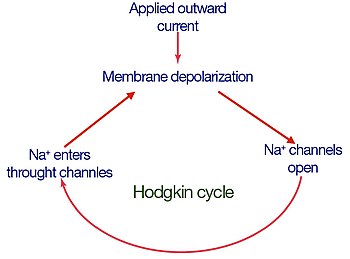Hodgkin cycle

In membrane biology, the Hodgkin cycle is a key component of membrane physiology that describes bioelectrical impulses. It was identified by British physiologist and biophysicist Sir Alan Lloyd Hodgkin.
The Hodgkin cycle represents a positive feedback loop in which an initial membrane depolarization leads to uncontrolled deflection of the membrane potential to near VNa. The initial depolarization must reach or surpass threshold in order to activate voltage-gated Na+ channels. Opening of Na+ channels allows Na+ inflow, which, in turn, further depolarizes the membrane. Additional depolarization activates additional Na+ channels. This cycle leads to a very rapid rise in Na+ conductance (gNa), which moves the membrane potential close to VNa. The cycle is broken when the membrane potential reaches to the sodium equilibrium potential and potassium channels open to re-polarize the membrane potential. This positive feedback loop means that the closer these voltage-gated Na+ channels are to each other, the lower the threshold of activation.
It is important to understand membrane physiology in order to understand how cells communicate with one another. Signalling between cells, such as neurons for example, revolves around changes in the electrical potentials across their membranes. In a healthy cell at rest, the intracellular area is usually negatively charged relative to the extracellular region. Depolarization refers to when the intracellular region becomes less negatively charged relative to the extracellular region. The concentration of sodium ions is intimately related to the electrical potential across a membrane. Depolarization often occurs via the influx of sodium ions to the intracellular region. Given sodium ions have a positive charge, the intracellular region becomes less negatively charged relative to the extracellular region.
